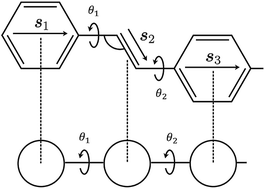Using spectroscopy to probe relaxation, decoherence, and localization of photoexcited states in π-conjugated polymers
Abstract
We use the coarse-grained Frenkel–Holstein model to simulate the relaxation, decoherence, and localization of photoexcited states in conformationally disordered π-conjugated polymers. The dynamics are computed via wave-packet propagation using matrix product states and the time evolution block decimation method. The ultrafast (i.e., t < 10 fs) coupling of an exciton to C–C bond vibrations creates an exciton–polaron. The relatively short (ca. 10 monomers) exciton-phonon correlation length causes ultrafast exciton-site decoherence, which is observable on conformationally disordered chains as fluorescence depolarization. Dissipative coupling to the environment (modelled via quantum jumps) causes the localization of quasi-extended exciton states (QEESs) onto local exciton ground states (LEGSs, i.e., chromophores). This is observable as lifetime broadening of the 0–0 transition (and vibronic satellites) of the QEES in two-dimensional electronic coherence spectroscopy. However, as this process is incoherent, neither population increases of the LEGSs nor coherences with LEGSs are observable.

- This article is part of the themed collection: Quantum effects in complex systems


 Please wait while we load your content...
Please wait while we load your content...